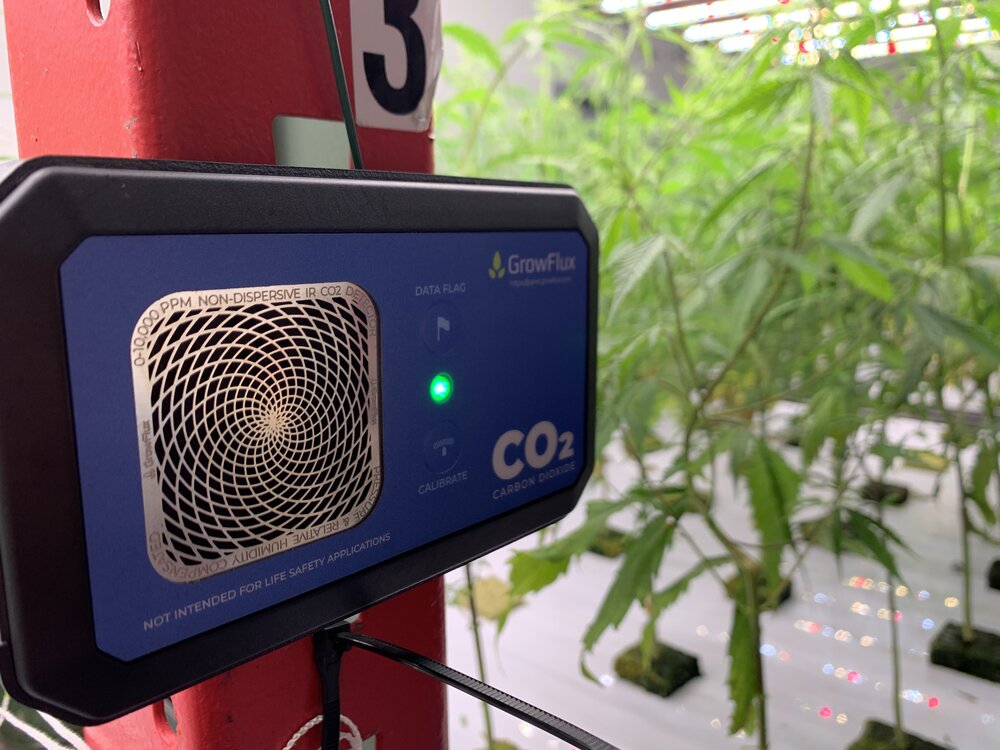
CO2 monitoring is all but necessary for indoor farmers and greenhouse cultivators looking to optimize yield, time to harvest, and energy consumption, however carbon dioxide concentration is difficult to measure in practice. Most CO2 detection techniques are difficult to optimize for battery life, and sensor equipment often uses fans and non-waterproof enclosures to let air into the sensing elements. Further, calibration procedures must be followed for accurate CO2 sensing. For these reasons and others, most CO2 sensors require wired installation, limiting their use in a greenhouse or indoor farm.
GrowFlux’s CO2 Microclimate Sensor was born out of the frustrations of many growers and farmers who have tried and failed to use CO2 sensors originally designed for applications outside of agriculture. GrowFlux’s CO2 Microclimate Sensor brings several new features we developed based on our experience working with indoor growers, including cloud connectivity and cloud based datalogging, a splash resistant enclosure that lets gases into the detector while maintaining a 5 minute response time, and wire free installation with high reliability GrowFlux Mesh wireless connectivity. These key features allow growers to place the sensors anywhere among the plant canopy, zeroing in on the microclimate variations that are affecting their crops.
Detection technique
There are two basic types of carbon dioxide sensing techniques, and not all detection techniques are equal.
Capacitive sensing - also known as CMOS gas sensing - this technique uses a small semiconductor chip inside the sensor that is coated in a specialized coating and layered with a micro heating plate. This low cost sensor detects gases such as CO2, carbon monoxide, alcohols, volatile organic compounds (VOCs), and other gases by measuring the change in capacitance of the coating on the chip as it absorbs these gases. This type of sensor responds primarily to VOCs as well as hundreds of other compounds in the air, and is generally not well suited for horticultural use.
Non-dispersive infrared (NDIR) - this technique uses an infrared light source and an infrared detector to measure CO2 in the air; the optics and precision of these devices are highly engineered to only measure CO2 - NDIR detectors do not respond to other gases and VOCs in the air.
Not only does GrowFlux’s CO2 Microclimate Sensor use NDIR detection, it also compensates the measurement for atmospheric pressure and relative using a separate pressure sensor, giving optimal accuracy in varying conditions.
Wireless reliability
Wireless CO2 sensors can be placed closer to crops and across large areas. Wireless CO2 sensors can also be re-positioned easily to develop a better understanding of microclimates in your cultivation space. The wireless technology within the sensor can affect monitoring practices.
Response time
CO2 sensors typically use a permeable housing to protect sensitive detector elements from dust. The design of these protective housings greatly affects how fast air permeates into the detector, and in turn how fast a carbon dioxide sensor responds to changes in CO2 concentration in the air. Some sensors on the market can take up to an hour to stabilize to an accurate reading.
For horticulture applications using carbon dioxide supplementation, relatively fast response times are necessary to capture surges in CO2 concentration
Battery Life
Engineering NDIR CO2 detectors for long battery life is a complex challenge; up until 2020, very few battery powered CO2 sensors even existed.
Data
Sending the data directly to the cloud in real time unlocks the full potential of the data; cloud based data logging makes the sensor data visible in real time, opening up integrations with other applications and systems. In our experience, logging devices which store sensor data locally lead to poor data collection practices - personnel lose data, get lazy and stop consistently gathering data, and often don’t budget the time to manage the data with spreadsheets.
As with any cloud connected sensor, be sure to select a sensor that allows for raw data download and integration with other systems with a software API.
Calibration
All CO2 sensors drift in accuracy slowly over time. Look for a sensor with a robust and easy to perform calibration procedure. We have even seen some sensors marketed for horticulture use that entirely lack calibration methods. Some CO2 sensors on the market are built first for indoor air quality sensing in buildings, where the CO2 concentration typically drops to outdoor ambient levels at some point each 24 hours - these sensors often use autocalibration techniques based on this diurnal rhythm. Such autocalibration methods will lead to inaccurate data when used in horticulture.
GrowFlux’s CO2 Microclimate Sensor can be calibrated outdoors in minutes without any specialized equipment.